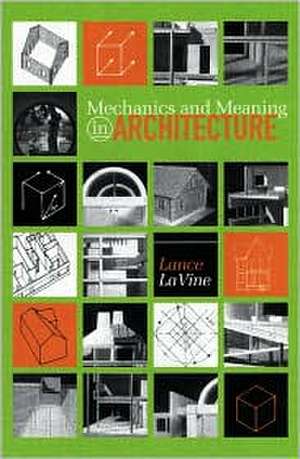Mechanics and Meaning in Architecture
Autor Lance Lavineen Limba Engleză Paperback – 16 mar 2001
An exploration of technology’s role in architecture and humanity’s understanding of nature.
In Mechanics and Meaning in Architecture, Lance LaVine shows that in architecture, as practiced and taught today, the technological aspect of the profession—how weight is distributed, how heat flow is regulated, and how light is permitted to enter—has been ceded to engineers and other technical specialists. And in doing so, he argues, architects have lost sight of one of architecture’s most important purposes, that of providing a literal and figurative window onto the world.
As a technology of habitation, architecture should give people both a practical and a metaphorical understanding of their relationship with nature. For LaVine, this knowledge emanates from a sensual understanding of the natural world as a “felt force.” At its most basic level, architecture demands an understanding of and response to the natural forces of gravity, climate, and sunlight. At the center of Mechanics and Meaning in Architecture are case studies of four very different houses: a Finnish log farmhouse from the nineteenth century; Charles Moore’s house in Orinda, California; Tadao Ando’s Wall House in Japan; and Le Corbusier’s Villa Savoye near Paris. Through his imaginative readings of structures, LaVine highlights how the architects involved have used the oldest and most fundamental architectural technologies-walls, floors, ceilings, columns, beams, and windows-in ways that offer creative responses to the natural world and humanity’s place in it.Clearly, architects are comfortable with the practical and aesthetic components of their profession. With this book, Lance LaVine encourages them also to understand what makes their use of technology unique and essential, and to reclaim the natural world for meaningful interpretation in their design of buildings.
In Mechanics and Meaning in Architecture, Lance LaVine shows that in architecture, as practiced and taught today, the technological aspect of the profession—how weight is distributed, how heat flow is regulated, and how light is permitted to enter—has been ceded to engineers and other technical specialists. And in doing so, he argues, architects have lost sight of one of architecture’s most important purposes, that of providing a literal and figurative window onto the world.
As a technology of habitation, architecture should give people both a practical and a metaphorical understanding of their relationship with nature. For LaVine, this knowledge emanates from a sensual understanding of the natural world as a “felt force.” At its most basic level, architecture demands an understanding of and response to the natural forces of gravity, climate, and sunlight. At the center of Mechanics and Meaning in Architecture are case studies of four very different houses: a Finnish log farmhouse from the nineteenth century; Charles Moore’s house in Orinda, California; Tadao Ando’s Wall House in Japan; and Le Corbusier’s Villa Savoye near Paris. Through his imaginative readings of structures, LaVine highlights how the architects involved have used the oldest and most fundamental architectural technologies-walls, floors, ceilings, columns, beams, and windows-in ways that offer creative responses to the natural world and humanity’s place in it.Clearly, architects are comfortable with the practical and aesthetic components of their profession. With this book, Lance LaVine encourages them also to understand what makes their use of technology unique and essential, and to reclaim the natural world for meaningful interpretation in their design of buildings.
Preț: 157.25 lei
Preț vechi: 189.62 lei
-17% Nou
Puncte Express: 236
Preț estimativ în valută:
30.09€ • 31.48$ • 24.100£
30.09€ • 31.48$ • 24.100£
Carte indisponibilă temporar
Doresc să fiu notificat când acest titlu va fi disponibil:
Se trimite...
Preluare comenzi: 021 569.72.76
Specificații
ISBN-13: 9780816634774
ISBN-10: 0816634777
Pagini: 242
Ilustrații: 67 black-and-white photos, 49 line drawings, 5 maps
Dimensiuni: 149 x 229 x 15 mm
Greutate: 0.71 kg
Ediția:First edition
Editura: University of Minnesota Press
Colecția Univ Of Minnesota Press
Locul publicării:United States
ISBN-10: 0816634777
Pagini: 242
Ilustrații: 67 black-and-white photos, 49 line drawings, 5 maps
Dimensiuni: 149 x 229 x 15 mm
Greutate: 0.71 kg
Ediția:First edition
Editura: University of Minnesota Press
Colecția Univ Of Minnesota Press
Locul publicării:United States
Notă biografică
Lance LaVine is professor of architecture and landscape architecture at the University of Minnesota.
